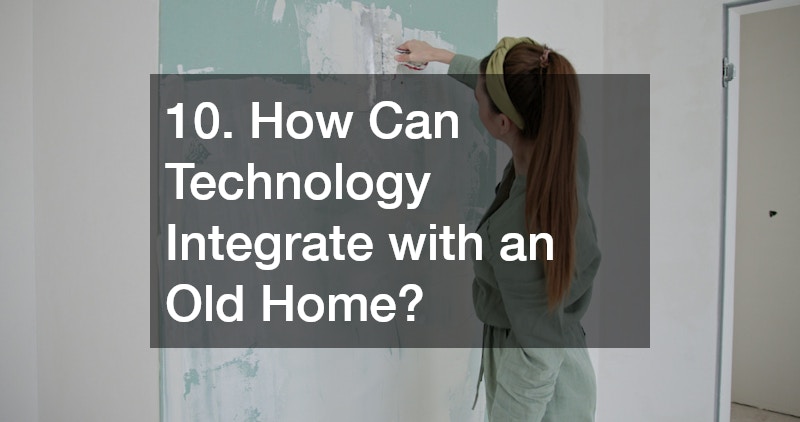Transforming an old home into a modern masterpiece is one of the most rewarding projects a homeowner can undertake. It combines the romance of history with the comfort and functionality of today’s innovations. However, breathing new life into an older property requires more than just cosmetic changes—it demands a strategic approach that respects the home’s character while addressing outdated systems, safety concerns, and efficiency issues.
Older homes often come with stories embedded in their walls, from unique architectural details to handcrafted finishes that can’t easily be replicated today. Yet, they also present challenges such as outdated wiring, aging plumbing, inefficient insulation, or structural wear. The key is to strike a balance between preservation and progress, blending historic craftsmanship with modern design and technology.
This guide will walk you through every step of modernizing your old home—from assessing its structural integrity to upgrading systems, improving efficiency, and integrating smart technology. Along the way, we’ll explore how specialists like tree removal companies, remodeling contractors, excavation experts, and HVAC professionals can support your vision. Whether you want to restore a century-old farmhouse or rejuvenate a mid-century bungalow, this comprehensive guide will help you create a home that honors the past while embracing the future.
1. How Do I Assess the Structural Integrity of My Old Home?

Before any modernization begins, it’s essential to ensure your home is structurally sound. Many older homes were built using materials and techniques that have stood the test of time—but even the most solid construction can degrade over decades of wear, moisture exposure, or ground movement.
Start by inspecting the foundation for cracks, uneven settling, or water intrusion. Basement dampness or bowing walls can indicate deeper issues. Engage a structural engineer to evaluate these concerns thoroughly. They can identify weaknesses that may not be visible to the untrained eye, such as wood rot, termite damage, or compromised load-bearing elements.
It’s also wise to check the home’s surroundings. Mature trees can pose a risk to foundations and roofing structures, particularly if roots extend beneath the home or branches overhang the roofline. Hiring tree removal companies can help mitigate these risks. Professionals can safely trim or remove problematic trees, ensuring your property’s long-term safety while maintaining the landscape’s beauty.
Finally, assess the roof, framing, and masonry. Pay attention to sagging ceilings or cracks in plaster—these may signal shifting or settling. Once the structure’s health is confirmed, you can confidently move forward with renovations knowing your foundation is secure and ready to support modern upgrades.
2. What Are the Best Ways to Update the Electrical System?
One of the most critical aspects of modernizing an older home is upgrading its electrical system. Homes built before the 1970s often rely on outdated wiring, insufficient amperage, or unsafe configurations that can’t support modern appliances and devices.
A remodeling contractor experienced in older homes can coordinate this process. They’ll typically work alongside licensed electricians to replace old knob-and-tube or aluminum wiring with modern copper wiring. This not only improves safety but also ensures that your system can handle today’s electrical demands—everything from smart lighting to high-efficiency appliances.
Consider adding ground fault circuit interrupters (GFCIs) in kitchens, bathrooms, and outdoor spaces to protect against electrical shock. Upgrading the electrical panel is also crucial. A 200-amp service panel is standard for modern households, offering the capacity to support additional circuits for future expansion.
Lighting upgrades provide an opportunity to blend modern function with classic style. For instance, recessed LED lighting can brighten dark rooms without disrupting original architectural details. You can also install dimmer switches or smart lighting systems that adjust automatically based on time of day or occupancy—merging old-world charm with cutting-edge convenience.
3. How Can I Improve the Energy Efficiency of My Historic Home?
Many historic homes were built in eras before insulation, air sealing, and energy-efficient windows were standard. As a result, they often lose heat in the winter and absorb excess heat in the summer. Improving energy efficiency not only reduces utility bills but also enhances comfort year-round.
Begin with a professional energy audit to identify areas of heat loss. Common problem spots include attic spaces, crawl areas, and around windows and doors. An excavation company can play an important role here—especially if you plan to add insulation to basements or improve drainage around the foundation. Proper grading and drainage prevent moisture accumulation, which protects both insulation and structure.
Next, upgrade windows strategically. If your home has original wooden windows, consider weatherstripping and adding storm windows rather than replacing them entirely. This preserves character while improving performance. For insulation, cellulose or spray foam can be added in attics and wall cavities without disturbing interior finishes too much.
You might also invest in a modern HVAC system designed for older homes. Ductless mini-split systems, for example, offer energy-efficient climate control without requiring extensive ductwork—a perfect solution for maintaining architectural integrity while improving comfort.
4. What Are Cost-Effective Ways to Modernize Plumbing?

Old plumbing can be one of the most frustrating challenges in historic homes. Galvanized pipes, for instance, are prone to corrosion and can restrict water flow or cause discoloration. Replacing these with modern materials like PEX or copper greatly improves water quality and reliability.
A trusted HVAC company often coordinates with plumbing specialists to update both water and heating systems efficiently. When modernizing, start by replacing visible and accessible pipes—such as those in basements or crawlspaces—before tackling walls or floors. If a full re-pipe isn’t feasible, consider targeted updates for high-demand areas like kitchens and bathrooms.
Adding low-flow fixtures can also modernize your plumbing while conserving water. Upgrading water heaters to tankless models reduces energy waste and provides endless hot water—a smart investment for long-term savings. During this process, take the opportunity to inspect for leaks, check water pressure, and ensure proper drainage systems are in place.
5. How to Preserve the Historical Aesthetics While Modernizing?
One of the most rewarding aspects of renovating an old home is maintaining its timeless appeal. From ornate trim and woodwork to vintage tile and stained glass, these details define the home’s character. However, preserving them while incorporating modern conveniences requires thoughtful planning.
Start by identifying which architectural elements are essential to keep. This might include original molding, hardwood floors, or period fireplaces. Collaborate with restoration experts or a fencing company that specializes in maintaining the traditional look of your property’s exterior features, such as iron railings, gates, or perimeter fences. These professionals can repair rather than replace, helping preserve your home’s authenticity.
Inside, balance historical textures with contemporary materials. For example, pair original wainscoting with sleek light fixtures or combine vintage flooring with modern furniture. When updating walls, consider using neutral palettes that highlight historic features rather than overshadow them.
Finally, if you must replace old elements, choose materials that replicate the originals in appearance and quality. Today’s manufacturing advances make it easier to find reproductions that maintain heritage aesthetics while offering modern durability.
6. Can I Enhance My Home’s Curb Appeal on a Budget?
Curb appeal sets the tone for your entire home, and enhancing it doesn’t have to break the bank. Start with simple landscaping improvements—trimming overgrown shrubs, reseeding the lawn, and planting seasonal flowers for color. If large or dangerous trees overshadow your property, consult professionals for safe trimming or removal.
Exterior masonry restoration can make an enormous difference. Repairing or repointing brickwork gives the facade a clean, refreshed look. You can also power wash stone or brick surfaces to remove decades of grime without damaging the material. For wood siding, a new coat of paint in a historically appropriate color revitalizes the entire exterior.
Lighting also plays a role in curb appeal. Add pathway lights, porch sconces, or accent lights that highlight architectural features. Replacing an old front door, restoring porch railings, or updating house numbers and mailboxes are other affordable ways to modernize your home’s exterior.
By combining these modest investments, you’ll create a welcoming, well-maintained exterior that reflects both pride and personality.
7. What Flooring Solutions Are Best for Updating an Old Home?

Flooring can dramatically transform the look and feel of an older home. Many historic homes feature hardwood floors that, when refinished, can rival new installations in beauty and durability. Sanding and resealing these floors not only preserves history but also saves money compared to full replacement.
If sections of the flooring are too damaged, consider installing new hardwood that matches the existing species and grain. For areas where moisture is a concern, such as basements or kitchens, luxury vinyl plank (LVP) or engineered wood can mimic traditional aesthetics while offering enhanced durability.
A roofing contractor can also provide insights when flooring renovations overlap with insulation or structural concerns—especially in attic conversions or upper floors where temperature fluctuations affect the subfloor. Addressing insulation under floors ensures comfort and energy efficiency.
Rugs and runners can be used strategically to protect original flooring while adding warmth and texture. Combining old-world materials with modern finishes keeps the home cohesive and inviting.
8. How Do I Modernize the Kitchen While Retaining Its Charm?
The kitchen is often the heart of a home, and modernizing it in an older property requires special attention to balance functionality with heritage. Start by preserving key architectural details such as exposed beams, brick walls, or built-in cabinetry. These features provide instant character that newer homes often lack.
Collaborating with a gutter repair or remodeling specialist can ensure your updates align with the overall structure’s condition—especially if you’re moving plumbing or electrical lines. Consider reconfiguring the layout for better flow while maintaining original design cues, such as traditional cabinetry styles or period-appropriate hardware.
Modern appliances can seamlessly blend into vintage kitchens through integrated designs. Panel-ready refrigerators and hidden dishwashers maintain a cohesive, classic look. Quartz or butcher block countertops pair beautifully with original materials, providing durability without clashing with the home’s personality.
Lighting upgrades are another opportunity to modernize while keeping charm intact. Pendant lights with retro designs or warm under-cabinet LEDs can make the kitchen both functional and inviting. The result? A space that honors its history while meeting today’s lifestyle demands.
9. What Are the Best Approaches for Modernizing Bathrooms?
Bathrooms in older homes often feature small footprints, outdated fixtures, or inefficient layouts. Fortunately, modernization can make them more functional and visually appealing without losing their vintage essence.
Start by updating plumbing systems to prevent leaks or low water pressure. An HVAC repair professional can help improve ventilation—critical for preventing moisture damage and maintaining indoor air quality. Installing a modern exhaust fan with humidity sensors ensures comfort and longevity for finishes.
Tile selection offers another chance to bridge old and new. Subway tiles, hexagonal mosaics, or natural stone can evoke a timeless feel while providing a fresh aesthetic. Add modern touches such as frameless glass showers, floating vanities, or energy-efficient lighting to create a spa-like environment that complements your home’s classic charm.
10. How Can Technology Integrate with an Old Home?

Integrating modern technology into an old home may seem challenging, but with the right approach, it’s possible to enjoy cutting-edge convenience without compromising charm. The goal is to make upgrades as seamless and unobtrusive as possible.
Start with siding suppliers or exterior renovation professionals who can discreetly incorporate modern insulation or wiring behind walls and facades. Smart thermostats, lighting systems, and security cameras can be installed with minimal intrusion using wireless technology.
Consider a central smart hub that allows you to control heating, cooling, lighting, and even window shades from your phone or voice commands. For entertainment, recessed speakers or hidden television mounts can provide modern experiences while preserving historic ambiance.
Technology can also improve safety and sustainability. Leak detectors, smoke alarms, and smart locks add layers of security, while smart water meters and solar integrations enhance efficiency.
The key is subtlety—letting technology enhance comfort and usability without drawing attention away from your home’s timeless character.
Modernizing an old home is a journey that celebrates both history and innovation. With careful planning, you can retain the craftsmanship and personality that make older homes special while introducing the energy efficiency, safety, and convenience of modern living. From working with tree removal and excavation professionals to partnering with remodeling contractors and HVAC experts, every step requires thoughtful coordination.
Ultimately, modernization isn’t about erasing the past—it’s about honoring it. When done right, your renovated home becomes a living testament to timeless design and forward-thinking improvement—a space that bridges generations and welcomes the future with open arms.
